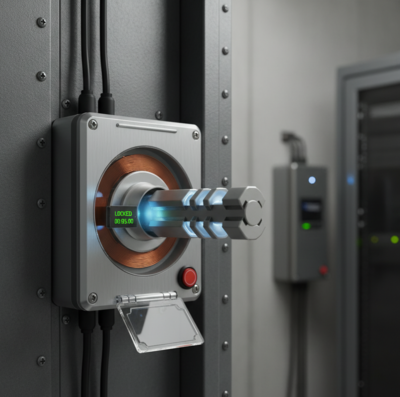In the era of smart access control, electromagnetic bolts have become an essential security solution. Unlike traditional mechanical locks, these devices use electromagnetic force to hold doors, offering superior reliability and seamless integration into electronic security systems.
If you’re looking to modernize the security of your company, warehouse, or building, it’s essential to know the main types of electromagnetic bolts available. Your choice will depend on how you prioritize security in case of a power outage.
1. Passive Security Bolts (Fail-Secure)
These are the preferred choice when access restriction is the top priority.
- The bolt is designed to remain closed and locked in the event of a power failure or outage.
- Used in high-security areas such as vaults, high-value storage rooms, or server rooms.
- Ensures that even without power, the door remains closed, maintaining the integrity of assets.
Most common passive security models: CU20/CP, ERC30/CP.
2. Active Security Bolts (Fail-Safe)
Essential for any evacuation plan or scenario involving human safety.
- The mechanism is designed to release the door and open automatically in the event of a power interruption.
- Used in emergency exits, evacuation routes, and any door that must ensure quick and safe egress in case of fire or general failure.
- Prioritizes human life, ensuring no one is trapped during an electrical emergency.
Most common active security models: ER30/CCR, CU20/CPXU, CU30/CP.
3. Bistable Bolts (Low Consumption)
The most efficient and versatile option in terms of energy management.
- They only require a short electrical pulse to change their state (from open to closed, or vice versa). Afterwards, they maintain that position without constant power.
- Commonly used in applications that seek to optimize energy consumption and where the bolt must remain in one state for long periods without continuous power supply.
- Significant reduction in energy use and lower heat generation.
Most common bistable bolts: CU20/CPB, ERB35-05/NDBCP.
4. Bolt Locks with Cut-Off Contacts
They add a layer of intelligence and feedback to your access control system.
- They include contacts that allow the system to monitor in real time whether the bolt is engaged and if the door is properly closed.
- Commonly used in Building Management Systems (BMS) and high-security environments where having digital confirmation of the door’s physical status is critical.
- They provide greater control and traceability over access, detecting tampering attempts or locking failures.
Choosing the right electromagnetic bolt is a key step to ensuring the safety of your facilities. The first step is to determine whether you need a Fail-Secure system (security priority) or a Fail-Safe system (evacuation priority) to implement a robust and compliant access control solution.

